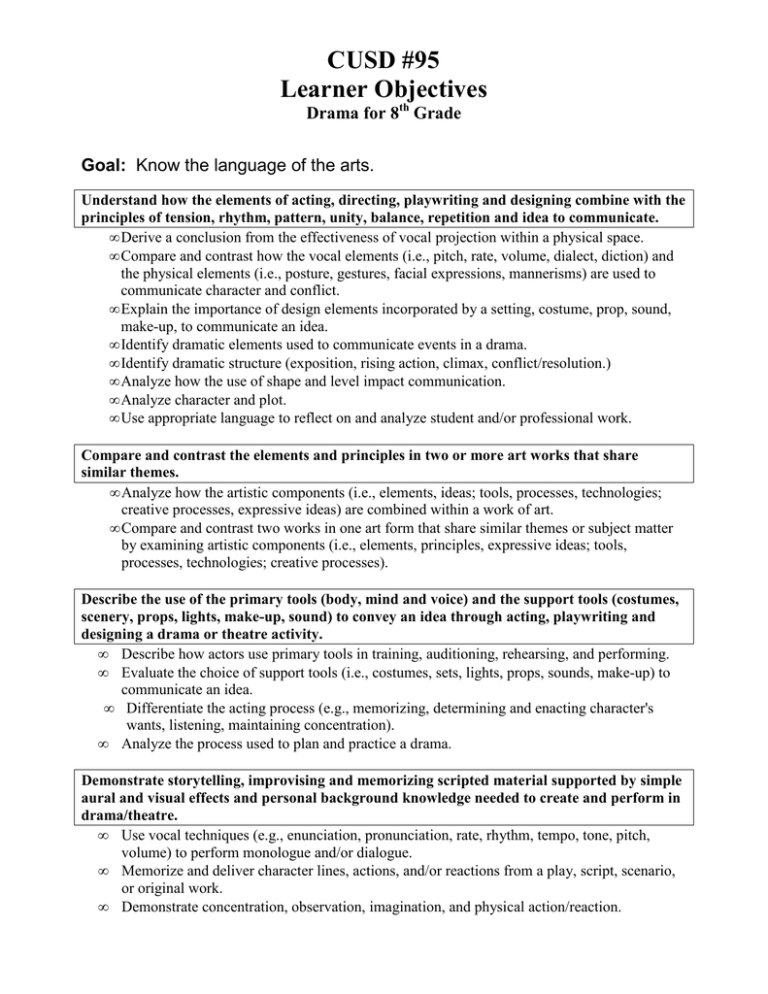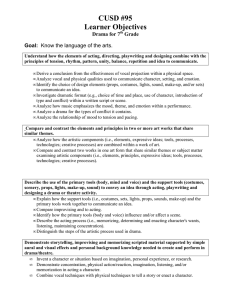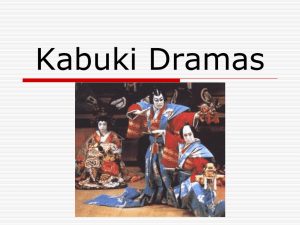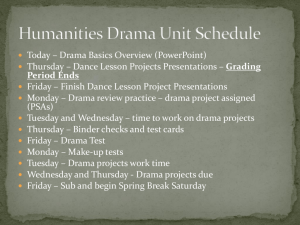CUSD #95 Learner Objectives Drama for 8 Grade
advertisement

CUSD #95 Learner Objectives Drama for 8th Grade Goal: Know the language of the arts. Understand how the elements of acting, directing, playwriting and designing combine with the principles of tension, rhythm, pattern, unity, balance, repetition and idea to communicate. • Derive a conclusion from the effectiveness of vocal projection within a physical space. • Compare and contrast how the vocal elements (i.e., pitch, rate, volume, dialect, diction) and the physical elements (i.e., posture, gestures, facial expressions, mannerisms) are used to communicate character and conflict. • Explain the importance of design elements incorporated by a setting, costume, prop, sound, make-up, to communicate an idea. • Identify dramatic elements used to communicate events in a drama. • Identify dramatic structure (exposition, rising action, climax, conflict/resolution.) • Analyze how the use of shape and level impact communication. • Analyze character and plot. • Use appropriate language to reflect on and analyze student and/or professional work. Compare and contrast the elements and principles in two or more art works that share similar themes. • Analyze how the artistic components (i.e., elements, ideas; tools, processes, technologies; creative processes, expressive ideas) are combined within a work of art. • Compare and contrast two works in one art form that share similar themes or subject matter by examining artistic components (i.e., elements, principles, expressive ideas; tools, processes, technologies; creative processes). Describe the use of the primary tools (body, mind and voice) and the support tools (costumes, scenery, props, lights, make-up, sound) to convey an idea through acting, playwriting and designing a drama or theatre activity. • Describe how actors use primary tools in training, auditioning, rehearsing, and performing. • Evaluate the choice of support tools (i.e., costumes, sets, lights, props, sounds, make-up) to communicate an idea. • Differentiate the acting process (e.g., memorizing, determining and enacting character's wants, listening, maintaining concentration). • Analyze the process used to plan and practice a drama. Demonstrate storytelling, improvising and memorizing scripted material supported by simple aural and visual effects and personal background knowledge needed to create and perform in drama/theatre. • Use vocal techniques (e.g., enunciation, pronunciation, rate, rhythm, tempo, tone, pitch, volume) to perform monologue and/or dialogue. • Memorize and deliver character lines, actions, and/or reactions from a play, script, scenario, or original work. • Demonstrate concentration, observation, imagination, and physical action/reaction. CUSD #95 Learner Objectives Drama for 8th Grade • • Demonstrate verbal and non-verbal choices in character interpretation showing physical, emotional, and/or environmental influences. Select set, props, costumes, lights, and sounds to support a drama. Analyze how the arts function in history, society and everyday life. • Demonstrate good audience behavior and evaluate the behavior of self and others. • Describe how audience behavior changes a product or performance. • Discuss how various arts are used to persuade and promote ideas (e.g. political conventions, campaigns, advertising) Understand how the arts shape and reflect history, society and everyday life. • Analyze how the art form influenced society in a given time period.






